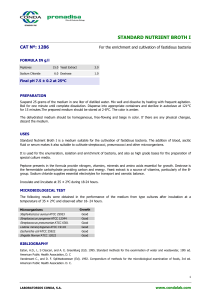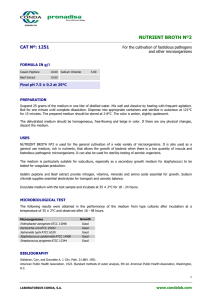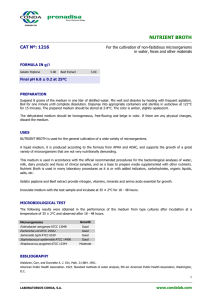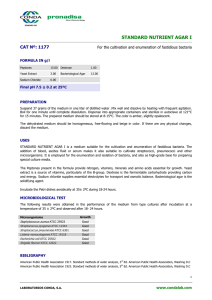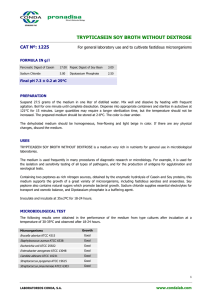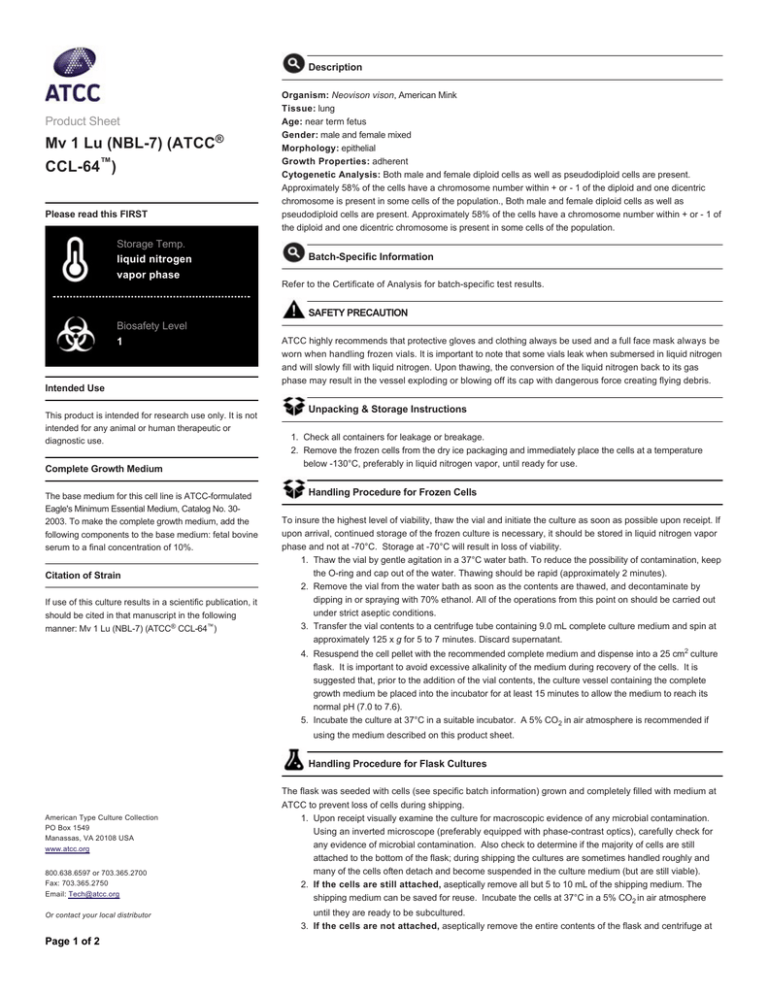
Description
Product Sheet
Mv 1 Lu (NBL­7) (ATCC®
CCL­64™)
Please read this FIRST
Storage Temp.
liquid nitrogen
vapor phase
Organism: Neovison vison, American Mink
Tissue: lung
Age: near term fetus
Gender: male and female mixed
Morphology: epithelial
Growth Properties: adherent
Cytogenetic Analysis: Both male and female diploid cells as well as pseudodiploid cells are present.
Approximately 58% of the cells have a chromosome number within + or ­ 1 of the diploid and one dicentric
chromosome is present in some cells of the population., Both male and female diploid cells as well as
pseudodiploid cells are present. Approximately 58% of the cells have a chromosome number within + or ­ 1 of
the diploid and one dicentric chromosome is present in some cells of the population.
Batch­Specific Information
Refer to the Certificate of Analysis for batch­specific test results.
SAFETY PRECAUTION
Biosafety Level
1
Intended Use
This product is intended for research use only. It is not
intended for any animal or human therapeutic or
diagnostic use.
Complete Growth Medium
The base medium for this cell line is ATCC­formulated
Eagle's Minimum Essential Medium, Catalog No. 30­
2003. To make the complete growth medium, add the
following components to the base medium: fetal bovine
serum to a final concentration of 10%.
Citation of Strain
If use of this culture results in a scientific publication, it
should be cited in that manuscript in the following
manner: Mv 1 Lu (NBL­7) (ATCC® CCL­64™)
ATCC highly recommends that protective gloves and clothing always be used and a full face mask always be
worn when handling frozen vials. It is important to note that some vials leak when submersed in liquid nitrogen
and will slowly fill with liquid nitrogen. Upon thawing, the conversion of the liquid nitrogen back to its gas
phase may result in the vessel exploding or blowing off its cap with dangerous force creating flying debris.
Unpacking & Storage Instructions
1. Check all containers for leakage or breakage.
2. Remove the frozen cells from the dry ice packaging and immediately place the cells at a temperature
below ­130°C, preferably in liquid nitrogen vapor, until ready for use.
Handling Procedure for Frozen Cells
To insure the highest level of viability, thaw the vial and initiate the culture as soon as possible upon receipt. If
upon arrival, continued storage of the frozen culture is necessary, it should be stored in liquid nitrogen vapor
phase and not at ­70°C. Storage at ­70°C will result in loss of viability.
1. Thaw the vial by gentle agitation in a 37°C water bath. To reduce the possibility of contamination, keep
the O­ring and cap out of the water. Thawing should be rapid (approximately 2 minutes).
2. Remove the vial from the water bath as soon as the contents are thawed, and decontaminate by
dipping in or spraying with 70% ethanol. All of the operations from this point on should be carried out
under strict aseptic conditions.
3. Transfer the vial contents to a centrifuge tube containing 9.0 mL complete culture medium and spin at
approximately 125 x g for 5 to 7 minutes. Discard supernatant.
4. Resuspend the cell pellet with the recommended complete medium and dispense into a 25 cm2 culture
flask. It is important to avoid excessive alkalinity of the medium during recovery of the cells. It is
suggested that, prior to the addition of the vial contents, the culture vessel containing the complete
growth medium be placed into the incubator for at least 15 minutes to allow the medium to reach its
normal pH (7.0 to 7.6).
5. Incubate the culture at 37°C in a suitable incubator. A 5% CO2 in air atmosphere is recommended if
using the medium described on this product sheet.
Handling Procedure for Flask Cultures
American Type Culture Collection
PO Box 1549
Manassas, VA 20108 USA
www.atcc.org
800.638.6597 or 703.365.2700
Fax: 703.365.2750
Email: Tech@atcc.org
Or contact your local distributor
Page 1 of 2
The flask was seeded with cells (see specific batch information) grown and completely filled with medium at
ATCC to prevent loss of cells during shipping.
1. Upon receipt visually examine the culture for macroscopic evidence of any microbial contamination.
Using an inverted microscope (preferably equipped with phase­contrast optics), carefully check for
any evidence of microbial contamination. Also check to determine if the majority of cells are still
attached to the bottom of the flask; during shipping the cultures are sometimes handled roughly and
many of the cells often detach and become suspended in the culture medium (but are still viable).
2. If the cells are still attached, aseptically remove all but 5 to 10 mL of the shipping medium. The
shipping medium can be saved for reuse. Incubate the cells at 37°C in a 5% CO2 in air atmosphere
until they are ready to be subcultured.
3. If the cells are not attached, aseptically remove the entire contents of the flask and centrifuge at
125 x g for 5 to 10 minutes. Remove shipping medium and save. Resuspend the pelleted cells in 10
mL of this medium and add to 25 cm2 flask. Incubate at 37°C in a 5% CO2 in air atmosphere until cells
are ready to be subcultured.
Subculturing Procedure
Product Sheet
Mv 1 Lu (NBL­7) (ATCC®
CCL­64™)
Please read this FIRST
Storage Temp.
liquid nitrogen
vapor phase
Biosafety Level
1
Volumes are given for a 75 cm2 flask. Increase or decrease the amount of dissociation medium needed
proportionally for culture vessels of other sizes.
1. Remove and discard culture medium.
2. Briefly rinse the cell layer with 0.25% (w/v) Trypsin ­ 0.53 mM EDTA solution to remove all traces of
serum which contains trypsin inhibitor.
3. Add 2.0 to 3.0 mL of Trypsin­EDTA solution to flask and observe cells under an inverted microscope
until cell layer is dispersed (usually within 5 to 15 minutes).
Note: To avoid clumping do not agitate the cells by hitting or shaking the flask while waiting for the
cells to detach. Cells that are difficult to detach may be placed at 37°C to facilitate dispersal.
4. Add 6.0 to 8.0 mL of complete growth medium and aspirate cells by gently pipetting.
5. Add appropriate aliquots of the cell suspension to new culture vessels.
6. Incubate cultures at 37°C.
Subcultivation Ratio: A subcultivation ratio of 1:3 to 1:4 is recommended
Medium Renewal: Every 2 to 3 days
Cryopreservation Medium
Complete culture medium described above supplemented with 5% (v/v) DMSO.
Intended Use
This product is intended for research use only. It is not
intended for any animal or human therapeutic or
diagnostic use.
Complete Growth Medium
The base medium for this cell line is ATCC­formulated
Eagle's Minimum Essential Medium, Catalog No. 30­
2003. To make the complete growth medium, add the
following components to the base medium: fetal bovine
serum to a final concentration of 10%.
Cell culture tested DMSO is available as ATCC® Catalog No. 4­X.
References
References and other information relating to this product are available online at www.atcc.org.
Biosafety Level: 1
Appropriate safety procedures should always be used with this material. Laboratory safety is discussed in
the current publication of the Biosafety in Microbiological and Biomedical Laboratories from the U.S.
Department of Health and Human Services Centers for Disease Control and Prevention and National Institutes
for Health.
ATCC Warranty
Citation of Strain
If use of this culture results in a scientific publication, it
should be cited in that manuscript in the following
manner: Mv 1 Lu (NBL­7) (ATCC® CCL­64™)
ATCC® products are warranted for 30 days from the date of shipment, and this warranty is valid only if the
product is stored and handled according to the information included on this product information sheet. If the
ATCC® product is a living cell or microorganism, ATCC lists the media formulation that has been found to be
effective for this product. While other, unspecified media may also produce satisfactory results, a change in
media or the absence of an additive from the ATCC recommended media may affect recovery, growth and/or
function of this product. If an alternative medium formulation is used, the ATCC warranty for viability is no
longer valid.
Disclaimers
American Type Culture Collection
PO Box 1549
Manassas, VA 20108 USA
www.atcc.org
800.638.6597 or 703.365.2700
Fax: 703.365.2750
Email: Tech@atcc.org
Or contact your local distributor
Page 2 of 2
This product is intended for laboratory research purposes only. It is not intended for use in humans.
While ATCC uses reasonable efforts to include accurate and up­to­date information on this product sheet,
ATCC makes no warranties or representations as to its accuracy. Citations from scientific literature and
patents are provided for informational purposes only. ATCC does not warrant that such information has been
confirmed to be accurate.
This product is sent with the condition that you are responsible for its safe storage, handling, and use. ATCC
is not liable for any damages or injuries arising from receipt and/or use of this product. While reasonable effort
is made to insure authenticity and reliability of materials on deposit, ATCC is not liable for damages arising from
the misidentification or misrepresentation of such materials.
Please see the enclosed Material Transfer Agreement (MTA) for further details regarding the use of this
product. The MTA is also available on our Web site at www.atcc.org
Additional information on this culture is available on the ATCC web site at www.atcc.org.
© ATCC 2013. All rights reserved. ATCC is a registered trademark of the American Type Culture Collection. [07/22]

